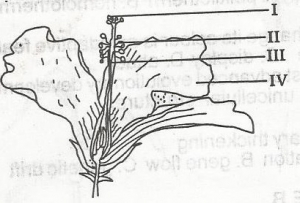
The eye defect illustrated in the diagram is
myopia
hypermetropia
astigmatism
cataract
Correct answer is B
Long-sightedness affects the ability to see nearby objects. You may be able to see distant objects clearly, but closer objects are usually out of focus.
It can be corrected using a convex lens.

In the diagram, the likely pollinating agent of the flower is?
wind
water
insect
man
Correct answer is C
adaptations of entomophilous / insected pollinated flowers are the following;
- Very conspicuous flowers with brightly coloured petals and perianths.
- Small flowers aggregate into inflorescence to become conspicuous.
- Flowers are usually scented to attract insects.

In the diagram, the male sex cells are contained in the part labelled
i
ii
iii
iv
Correct answer is B
Stamens are the male reproductive organs of flowering plants.
They consist of an anther, the site of pollen development, and in most species a stalk-like filament that transmits water and nutrients to the anther and positions it to aid pollen dispersal.

The habitat of the organism is
slow moving streams and marshes
the stomach of large mammals
under leaf filters on the forest floor
the small intestine of large vertebrates
Correct answer is D
Tapeworms generally inhabit the intestines of humans and animals. They have a series of hooks (or suckers) on one end that they use to attach to the intestine to get nourishment from the host.

In the diagram, the structure labelled X is for?
attachment
feeding
seeing
breathing
Correct answer is A
Suckers are the organs tapeworms use to attach to the host tissues.
JAMB Subjects
Aptitude Tests